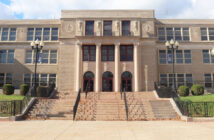“The darkness drops again but now I know / That twenty centuries of stony sleep / Were vexed to nightmare by a rocking cradle, / And what rough beast, its hour / come round at last, / Slouches towards Bethlehem to be born?”
W.B. Yeats wrote this poem, “Second Coming,” while political turmoil encompassed the globe in the wake of WWI.
Given Yeats’ peculiar use of “slouches” to mean working toward a target, it is interesting that Joan Didion — an American writer considered to be a pioneer of “New Journalism” — chose to entitle her collection of essays, “Slouching Towards Bethlehem.”
In their respective works, both authors recalled the events of social disasters. To Yeats, this was the global political unrest in 1919 that caused what he believed to be a loss of humanity’s sense of resolve. On the other hand, Didion took inspiration from the social environment of San Francisco during the 1960s.
In further interpreting Yeats’ abnormal phrase, it is evident that the writer took inspiration from biblical events. In times of unrest and mayhem, there will always be a force bringing about a new age or a second coming. There will always be a beast “slouching towards Bethlehem.”
Being able to live in Bethlehem, Pennsylvania, and witness the changes that are happening every day from the perspective of someone who is not familiar with the area is a truly unique experience. Coming from a small town in New Jersey, living in Bethlehem has been a big culture shock given the difference in lifestyles.
In the time that I have spent in this eccentric city, there has been a noticeable pattern concerning consumerism, causing the story of the city to ring an eerily similar tune to Yeats’ and Didion’s pieces. This similarity is only exacerbated by the fact that the city referenced in Yeats’ metaphor is Bethlehem’s namesake.
Looking at Bethlehem and its nearly 75,000 inhabitants, it is easy to see its beauty. Yet, it is also evident that history and industrial America have deserted the once-booming city that led the way in manufacturing steel.
As the steel empire fell, a blind eye was turned to Bethlehem and its population. This can especially be highlighted by corporate America’s presence, or lack thereof, in Bethlehem and its neighboring cities.
Given the lack of access to capital, companies looking to make a considerable profit do not place store locations in poverty-stricken areas. This is shown by the fact that the nearest Whole Foods to Bethlehem is 14 miles away, as just one example.
This bodes the question: what is the beast slouching toward Bethlehem now? What is the second coming of Bethlehem following the abandonment from industrial America?
It is evident that change is happening around us today. As a matter of fact, it would be very difficult to walk around Bethlehem without seeing some area undergoing construction — whether this be the new Five10 Flats on East Third Street, Toastique or Ideal Food Basket.
The “second coming” of Bethlehem is characterized by the emergence of consumerism that is typically geared toward those who have the ability to spend their money more freely.
As we watch these changes take place, it is important to remember that there is a diverse population of individuals residing in Bethlehem who will be disproportionately affected by such changes. Many citizens and business owners cannot afford to keep up with the city’s changes.
With these developments, corporations are the only benefactors. Rising market and housing values are not sustainable for the lives of citizens who already face housing and income struggles.
In the coming years, as businesses gear toward those with more disposable income who begin to settle in Bethlehem, it is important for city officials to remember that the majority of its inhabitants are low-income individuals who cannot afford lavish lifestyles and that low-cost businesses are essential to their survival.
These attempts to elevate the status of the city largely disregard those who call Bethlehem home and cannot afford the lifestyle of living in a modern, 21st-century city.






Comment policy
Comments posted to The Brown and White website are reviewed by a moderator before being approved. Incendiary speech or harassing language, including comments targeted at individuals, may be deemed unacceptable and not published. Spam and other soliciting will also be declined.
The Brown and White also reserves the right to not publish entirely anonymous comments.
1 Comment
You have clearly been sheltered during your time in Bethlehem as this city has already remade itself into a vibrant cultural & Historic icon. The recent Nomination of Historic Moravian Bethlehem across the river by the US Dept of Interior as a UNESCO World Heritage Site provides credibility to our region as a culturally significant Tourist destination.
This nomination if approved would put Bethlehem in the same league with Independence Hall, Statue of Liberty, & Monticello as East Coast World Heritage destinations. Combining this authentic Colonial history with the 19th Century Industrial era that marks the former Bethlehem Steel property & founding of Lehigh & we already have a vibrant town that still cherishes its historic roots.
The biggest threat to the lower income residents of the city has already occurred as Lehigh students moved off campus over the past 30 years disrupting & gentrifying those very Southside neighborhoods that you reference.